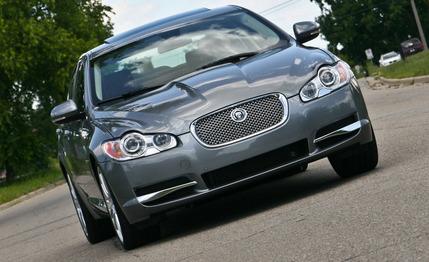 Short Take Road Test
Short Take Road Test

When the Jaguar XF first went on sale in the U.S. in 2008, it did so with two engines: a naturally aspirated 300-hp, 4.2-liter V-8 and a 420-hp supercharged version of the same unit. Just over a year after the car was launched, however, Jaguar has completely revamped the powertrain lineup and the range. The base XF retains its 4.2-liter engine, but the XF Premium model features a naturally aspirated, direct-injected 5.0-liter V-8 making 385 hp and 380 lb-ft of torque. The XF Supercharged model adds a supercharger to the Premium’s direct-injected 5.0-liter, good for 470 hp, and the range-topping XFR gets a 510-hp version of the same engine.
The Premium model offers the best combination of performance and value in the XF range and carries a base price of $57,000, roughly $11,000 less than the XF Supercharged. The car comes well equipped, with standard 19-inch wheels, navigation, heated and cooled leather seats, blind-spot monitoring, front parking assist, a rearview camera, bixenon headlights, a sunroof, and a power tilting-and-telescoping steering column.
The only available options are a premium sound system, a heated leather steering wheel—which was fitted to our tester and bumped the price up $300—adaptive cruise control, and a power rear sunshade. Sybarites can also opt for the Portfolio package that adds 20-inch wheels, a suede headliner, deep-pile carpeting, and contrasting stitching for $4000.
Less Power, Equal Performance
Like all XFs, the Premium model moves sweetly down the road, with a supple ride that’s married to good body control, accurate steering, and nicely balanced handling. The new engine is a sweetheart, with excellent midrange response and a muted growl under hard acceleration. The six-speed automatic transmission shifts smoothly and has an excellent manual override, orchestrated via paddles on the steering wheel.
Compared with the old supercharged model, which had 35 more horsepower and only about 25 more pounds to lug around, we recorded remarkably similar acceleration times for the new 5.0. Zero to 60 mph took 5.1 seconds versus 5.0 for the forced-induction car, and the quarter-mile was dispatched in 13.6 seconds at 106 mph compared with 13.5 at 107. In passing maneuvers, however, the new XF 5.0 was 0.1 second faster from 30 to 50 mph and from 50 to 70 mph, at 2.6 and 3.5 seconds, respectively. Braking performance was excellent, with the 70-to-0-mph stop taking 157 feet, just two feet longer than both a Porsche 911 Carrera S and Cayman S. The EPA gives the 5.0 fuel-economy figures of 16 mpg city and 23 highway; our lead feet managed 20 mpg overall, which was the same as our long-term 2009 XF Supercharged achieved over 40,000 miles.
Flawed Beauty, Nice Package
However, there are still some areas in the XF that need addressing. The infotainment and climate-control systems are only accessible through submenus that are byzantine at best and perverse at worst. Jaguar is supposedly going to add hard buttons for the seat heaters instead of the touch screen interface that currently exists, a move that can’t come soon enough. The unique pop-up rotary shift selector looks cool, but it still seems gimmicky. Rear-seat headroom for taller occupants isn’t the best in class, either.
Despite its quirks, the XF is a solid luxury package overall. It looks terrific and distinctive, has a clean and modern interior, and has one of the best ride-and-handling balances in its class. At the price of our tester, it undercuts the less-powerful Audi A6 4.2 and BMW 550i by about $4000 and is a hair cheaper than the 382-hp 2010 Mercedes-Benz E550, which isn’t as well equipped as the Jag. But as far as the XF goes, it’s hard to see a reason to move up to either of the supercharged versions, especially considering their added cost.